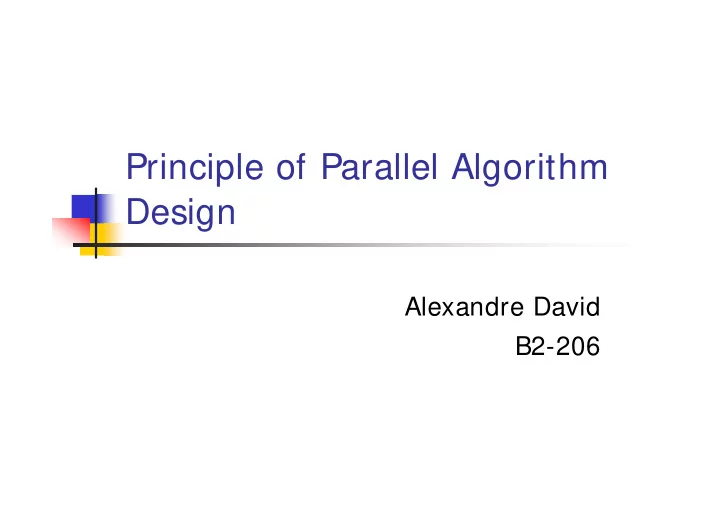

Principle of Parallel Algorithm Design Alexandre David B2-206
Today � Preliminaries (3.1). � Decomposition Techniques (3.2). � Surprise. 21-02-2006 Alexandre David, MVP'06 2
Overview � Introduction to parallel algorithms. � Tasks and decomposition. � Processes and mapping. � Processes vs. processors. � Decomposition techniques. � Recursive decomposition. � Exploratory decomposition. � Hybrid decomposition. 21-02-2006 Alexandre David, MVP'06 3
Introduction � Parallel algorithms have the added dimension of concurrency . � Typical tasks: � Identify concurrent works. � Map them to processors. � Distribute inputs, outputs, and other data. � Manage shared resources. � Synchronize the processors. 21-02-2006 Alexandre David, MVP'06 4
Decomposing Problems � Decomposition into concurrent tasks. � No unique solution. � Different sizes. � Decomposition illustrated as a directed graph: � Nodes = tasks. � Edges = dependency. Task dependency graph 21-02-2006 Alexandre David, MVP'06 5
Example: Matrix * Vector Vector Task dependency graph? Matrix N tasks, 1 task/row: 21-02-2006 Alexandre David, MVP'06 6
Example: Database Query Processing MODEL = ``CIVIC'' AND YEAR = 2001 AND (COLOR = ``GREEN'' OR COLOR = ``WHITE) 21-02-2006 Alexandre David, MVP'06 7
8 Alexandre David, MVP'06 A Solution 21-02-2006
Another Solution 21-02-2006 Alexandre David, MVP'06 9
Granularity � Number and size of tasks. � Fine-grained: many small tasks. � Coarse-grained: few large tasks. � Related: degree of concurrency . � Maximal degree of concurrency. � Average degree of concurrency. 21-02-2006 Alexandre David, MVP'06 10
Coarser Matrix * Vector Vector Matrix N tasks, 3 task/row: 21-02-2006 Alexandre David, MVP'06 11
Granularity � Average degree of concurrency if we take into account varying amount of work? � Critical path = longest directed path between any start & finish nodes. � Critical path length = sum of the weights of nodes along this path. � Average degree of concurrency = total amount of work / critical path length. 21-02-2006 Alexandre David, MVP'06 12
Database Example Critical path (3). Critical path (4). Critical path length = 27. Critical path length = 34. Av. deg. of concurrency = 63/27. Av. deg. of conc. = 64/34. 2.33 1.88 21-02-2006 Alexandre David, MVP'06 13
Interaction Between Tasks � Tasks often share data. � Task interaction graph: � Nodes = tasks. � Edges = interaction. � Optional weights. � Task dependency graph is a sub-graph of the task interaction graph. 21-02-2006 Alexandre David, MVP'06 14
Example: Sparse Matrix Multiplication 21-02-2006 Alexandre David, MVP'06 15
Processes and Mapping � Tasks run on processors. � Process: processing agent executing the tasks. Not exactly like in your OS course. � Mapping = assignment of tasks to processes. � API expose processes and binding to processors not always controlled. 21-02-2006 Alexandre David, MVP'06 16
Mapping Example 21-02-2006 Alexandre David, MVP'06 17
Processes vs. Processors � Processes = logical computing agent. � Processor = hardware computational unit. � In general 1-1 correspondence but this model gives better abstraction. � Useful for hardware supporting multiple programming paradigms. Now remains the question: How do you decompose? 21-02-2006 Alexandre David, MVP'06 18
Decomposition Techniques � Recursive decomposition. � Divide-and-conquer. � Data decomposition. � Large data structure. � Exploratory decomposition. � Search algorithms. � Speculative decomposition. � Dependent choices in computations. 21-02-2006 Alexandre David, MVP'06 19
Recursive Decomposition � Problem solvable by divide-and-conquer: � Decompose into sub-problems. � Do it recursively. � Combine the sub-solutions. � Do it recursively. � Concurrency: The sub-problems are solved in parallel. 21-02-2006 Alexandre David, MVP'06 20
Quicksort Example <5 ≤ <3 ≤ <9 ≤ <10 ≤ <7 ≤ <11 ≤ 21-02-2006 Alexandre David, MVP'06 21
Minimal Number 4 9 1 7 8 11 2 12 21-02-2006 Alexandre David, MVP'06 22
Data Decomposition � 2 steps: � Partition the data. � Induce partition into tasks. � How to partition data? � Partition output data: � Independent “sub-outputs”. � Partition input data: � Local computations, followed by combination. 21-02-2006 Alexandre David, MVP'06 23
Matrix Multiplication 21-02-2006 Alexandre David, MVP'06 24
Intermediate Data Partitioning Linear combination of the intermediate results. 21-02-2006 Alexandre David, MVP'06 25
Owner Compute Rule � Process assigned to some data � is responsible for all computations associated with it. � Input data decomposition: � All computations done on the (partitioned) input data are done by the process. � Output data decomposition: � All computations for the (partitioned) output data are done by the process. 21-02-2006 Alexandre David, MVP'06 26
Exploratory Decomposition 15-puzzle example 21-02-2006 Alexandre David, MVP'06 27
28 Alexandre David, MVP'06 Search 21-02-2006
Anomalous Behavior Possible Work depends on the order of the search! 21-02-2006 Alexandre David, MVP'06 29
Speculative Decomposition � Dependencies between tasks are not known a-priori. � How to identify independent tasks? � Conservative approach: identify tasks that are guaranteed to be independent. � Optimistic approach: schedule tasks even if we are not sure – may roll-back later. 21-02-2006 Alexandre David, MVP'06 30
Speculative Decomposition Example ? 21-02-2006 Alexandre David, MVP'06 31
Recommend
More recommend